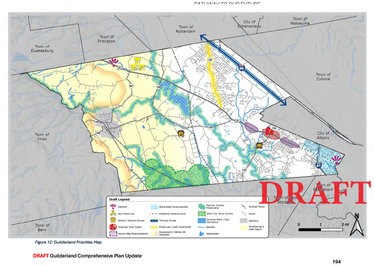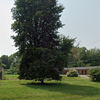The plan for Guilderland’s future is now in the hands of the town board
GUILDERLAND — The committee charged with updating Guilderland’s two-decades-old land-use plan has completed its task. The plan now moves to the town board for any additional revisions and ultimately adoption.
The Guilderland Comprehensive Plan Update Committee over the course of two meetings in October went over the final tweaks to the 198-page document, unanimously choosing on Oct. 29 to adopt and refer it to the town board.
The town board’s adoption process includes another public-comment period, referral of the plan to neighboring municipalities and the Albany County Planning Board, the State Environmental Quality Review Act (SEQR) process, another public hearing, and finally adoption.
Once the town board adopts the plan, it then will have to update the town’s zoning law if it wants to implement changes in the plan.
Altamont
The committee touched on a number of topics during its final meetings but “probably the most substantive change that has been made to the document” was to better define the relationship between the town and the village of Altamont, consultant Jaclyn Hakes told committee members at their early October meeting.
A third paragraph was added to the Oct. 10 draft introduction overview essentially acknowledging the village’s existence, stating it was “located within the geographical boundaries of the Town of Guilderland,” but is also “a distinct municipality with its own local government.”
And, although Altamont “shares services and a community identity with the larger town, it maintains independent authority over certain local matters, such as zoning and Village-specific services,” a structure that allows the village “to preserve its historic character and small-town governance, while still being an integral part of the broader Guilderland community.”
But the paragraph was not included in the draft approved Oct. 29.
The update committee did, however, continue to take a long look at the town’s relationship with the village of Altamont, underscoring a need for stronger collaboration on shared resources — water and infrastructure projects in particular.
But the committee also sought to make clear that the town would not be on the hook for any village-initiated water project, which isn’t something the village ever sought.
Water
Water in general was a major concern for the committee.
The regulatory maze around the Watervliet Reservoir, which sees overlapping rules from different agencies, raised a need for a specialized committee to keep tabs on its water quality. Committee members also floated the idea of inviting representatives from neighboring watershed towns, addressing pollution concerns from upstream.
When discussion turned to compliance and regulatory frameworks, the focus was largely on existing environmental guidelines, particularly around stormwater, with members cautioning against redundancies in the new plan.
Business
Turning to business and community engagement, the committee discussed expanding existing business roundtables to include voices from nearby communities, aiming to foster an approach that strengthens local business presence across town lines.
Connectivity
On sidewalk connectivity and pedestrian safety, an emerging topic was to extending sidewalks along Gun Club Road to link with the village’s park there.
Public comment about expanding the town’s Transit-Oriented Development District was taken into consideration but the committee, cautious of jumping into changes without fully understanding their implications stressed the need for a thorough study.
Housing
In discussing affordable housing, the committee conversation acknowledged the town’s pro-housing designation. However, it was noted that there are funding and logistical obstacles inherent in affordable projects.
Members suggested state partnerships and measures like accessory dwelling units, streamlined processes, and codified requirements for larger developments.
Accountability
When it came to implementation and monitoring of the plan, the committee sought a consistent method for tracking progress, proposing a five-year action plan with more frequent interim assessments.
Ensuring accountability, it was agreed, would likely require a dedicated oversight entity — be that a committee or the planning department itself.



